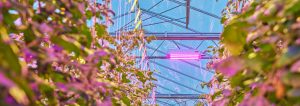Be the first! Get the latest news and updates - Subscribe to our newsletter!
Dynamic LED lighting yields significant savings
With high energy prices here to stay, we’ve seen big changes in the way growers are thinking about their use of light. High Pressure Sodium (HPS) lamps are being switched off and replaced with LED lights, which are not only more economical but have the option to be dimmed. Growers are learning that they still need to use artificial light, but it must be used smarter to combat costs - preferably without limiting crop growth, yield, or quality.
Two concepts are central to the new approach to artificial lighting: cost-effectiveness and flexibility. Plants need Photosynthetic Active Radiation (PAR) to grow. The trick to cost-effective growth is to give plants enough PAR light in the right composition of spectrum and intensity at the lowest possible cost to perform well. And just as electricity costs are not constant but can vary from hour to hour, a plant’s light requirements are not constant either. Research and practice have already shown that it can be beneficial for both plant development and energy bills to treat light as a dynamic growth factor. The days when light installations always ran at full power at fixed times will soon be a thing of the past.

Game elements
Cost effectiveness can therefore be regarded as a dynamic game with different variables, such as the PAR sum to be given per day or week, the required amounts of LED light to supplement natural daylight up to those amounts, and the distribution of lighting periods and lighting duration over the day and week to achieve those amounts as economically as possible. To make the game even more fun and challenging, you can also vary the spectrum offered, minimizing the use of less efficient colors. Some of these colors are necessary or desirable (e.g., far-red and green/white light), but through intelligent use of lighting, you can optimize these to the greatest extent possible. Of course, the lighting installation and software must be appropriate for this, and proper monitoring is needed to interpret and translate the crop reactions into appropriate actions.
Common sense
What can growers do now to save costs without a dynamic spectrum, but with a continuously dimmable LED installation, a handful of sensors, and a modern control system? First of all, say goodbye to fixed patterns. Let yourself be guided by the crop and the daylight that’s already available, and supplement that as needed. Keep in mind that light correction is also an option in addition to temperature correction. You can therefore light a little more at the less expensive times in a 24-hour period (night and early morning instead of late afternoon and evening) and even change throughout the week (more on weekends, less during the week).

Lighting as needed
Morning is a critical time for plant growth, and at night, electricity often costs less than in the evening. Why not make use of that? If you use lighting from midnight to 9 a.m. (possibly dimmed, which is more efficient than full strength), then you are already taking a nice chunk out of the required light sum. Then during the day, you may be able to keep the lamps off. If you need to continue running your lighting, it may be possible to dim the installation so that the plant can make maximum use of daylight. That, too, can be done dynamically.
Putting it to the test
In a comparison test at Botany, we apply the principles of timing and light correction to tomatoes. The research is done in two compartments that receive the same light sum on a weekly basis. In compartment 1, lighting is kept at a constant light sum of 220 μmol/m2/sec. The lighting duration is adjusted to the expected solar radiation. In the adjacent compartment, dynamic lighting is provided at a maximum light sum of 300 μmol/m2/sec, but dimming is also used. It is controlled based on electricity rates. The lowest energy price is on weekends and at night, therefore providing the most significant light input. Measurements are also taken to monitor crop responses and plant processes, such as evaporation, photosynthetic activity, increase in biomass, physical yield, and fruit quality.
How far can you go?
It is still too soon to make any definitive statements. Nevertheless, we already see increased favor for dynamic lighting. The energy costs are significantly lower, while the crop has performed similarly. We will undoubtedly come back to this later. How far do you think you can dim without sacrificing the quality?

Marcel Raats is a Plant Specialist at Signify in The Netherlands, with over 2.5 years of experience at the company and a long career in the vegetable seed industry. Marcel specializes in high wire greenhouse crops and works on optimizing grower results using LED light. He provides pre- and post-sales assistance to customers and is passionate about advancing Philips LED lighting technologies. Marcel brings a practical and research-focused approach to his work, helping to ensure the best possible service to customers.
Related articles
Contact us
Contact certified partners
Philips products are sold through a global network of certified partners. Find partners in your region for more information about Philips LED grow lights.
Contact Philips
What are the best LED grow lights for your situation? We are here to help. Please use our form to submit your request.
Interested?
Learn more about LED lighting in horticulture by reading our latest articles and case studies.




